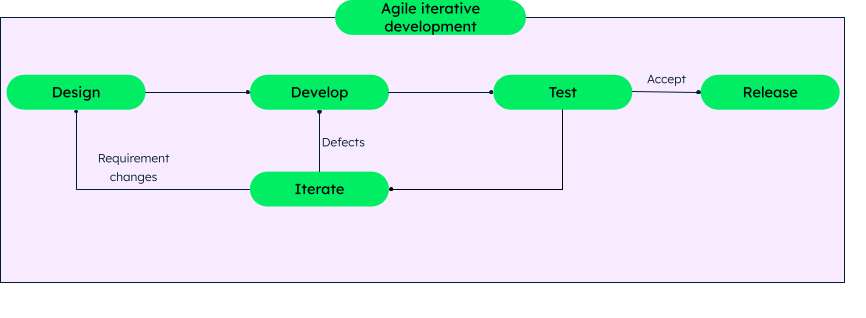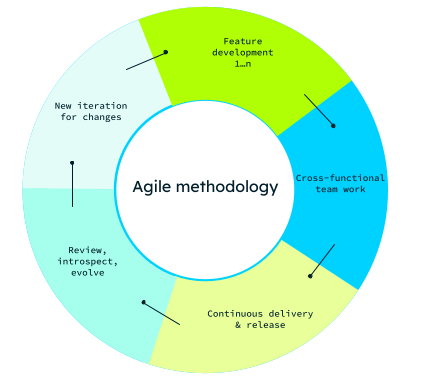Agile is a mindset or ability of individuals and teams to respond to changes and uncertainties. Agile is about how quickly you can understand the changes happening in an environment, adapt to them, and provide sustainable solutions.
Agile promotes business agility and delivers faster time to value, higher software quality, and, as the name implies, greater flexibility and adaptability to change. Agile practices cut down on extensive planning stages and fixed development cycles, enabling businesses to respond quickly to new requirements.
What is Agile development?
Agile development is a set of result-oriented software development methodologies that ensure an iterative, outcome-focused approach to building software. Teams release various features of the software at continuous intervals in an iterative manner, and requirements evolve as the software is delivered and tested. This approach is more efficient when compared to the traditional approach of rigorous planning and fixed linear stages.
 Agile development process where design, development, testing happens iteratively
Agile development process where design, development, testing happens iteratively
Agile development follows the following values and principles:
Core Agile values
- Individuals and interactions over tools and techniques
Although tools and techniques are effective in speeding up the development cycle, they are of no use if placed in the wrong hands. More team collaboration and regular meetings ensure everyone is on the same page.
- Working software over documentation
Projects require comprehensive documentation. However, as the software evolves, documentation may need changes too. Agile focuses on delivering the working software first, thus saving time on documentation and changes.
- Customer collaboration
Continuous testing, delivery, and feedback from customers is important to understand and work on requirement gaps as early as possible in the application development, rather than building an entire application and then changing it from scratch if a requirement doesn’t match customer expectations.
- Responding quickly to a change rather than following a rigid plan
Businesses are ever-evolving and so, a fixed plan may not always work. As business grows, demands and goals will continually change for good. Businesses should be flexible to quickly adapt to new changes and respond positively.
Agile principles
First expressed in the Agile Manifesto published in 2001, these 12 principles embody the best practices of a group of leading figures in software development.
- Early and continuous delivery of valuable software
Software development takes time, costs money, and exists to meet customer needs. Sooner equals better: The goal of Agile is to generate high-value applications early and often.
- Embrace change
The only thing permanent in business is change, so adjustments and modifications to application requirements should be expected and welcomed, even in late stages of development. The last thing users and customers need is software that’s outdated or irrelevant upon arrival.
- Frequent delivery
It’s never too early to generate value, which is why Agile focuses on a time frame of a couple of weeks to a couple of months. Think smaller releases, more often.
- Business and developers together
Agile emphasizes overcoming traditional silos and barriers to smooth collaboration between the development and business sides of the house. This way, misunderstandings are resolved before they can find their way into code, and feedback comes quickly enough to avert problems before users ever see them.
- Motivated individuals
Developers whose skills are empowered by the right training, environment, tools, and management support will naturally create successful projects.
- Face-to-face conversations
The best and most productive interactions are one on one. With modern tools like Zoom, Skype, and Hangouts, distributed teams can and should collaborate face to face over distances and time zones.
- Working software
If there’s one Agile rule that stands above all the rest, it’s that progress is measured not by models, analysis, or flowcharts... but by a real, live, functioning product.
- Sustained development
The essence here is continuity. Agile is about ongoing exertion, not one-time spurts. When successfully employed, its processes facilitate workflows that are consistent and sustainable over the long term.
- Technical excellence
Undeniably, Agile puts a premium on rapid development, but not at the expense of good design and technical quality. A mediocre product won’t fully meet user needs no matter how fast it gets delivered.
- Simplicity
Agile defines this as “the art of maximizing the amount of work not done.” This means, among other things, eliminating outmoded procedures, favoring automation over manual processes, using macro libraries where available, and in general, taking the most direct route to each given objective.
- Self-organizing teams
Good developers work best when they feel ownership in the work product. The key enabler rests with management. Higher-ups must trust the team to organize its efforts, consult with business stakeholders, and dive into coding—free from over-control or micro-management.
- Regular reflection and adjustment
No individual or group makes perfect decisions all the time. There’s always room for improvement. This makes it imperative for Agile teams to periodically assess, optimize, and finetune their efforts.
Key Agile concepts
Some key Agile concepts are:
Scrum: Scrum is the most popular Agile framework where a project is divided into smaller iterations called sprints. Each sprint consists of small tasks called user stories.
Sprint: Sprints are small iterative blocks of time, where key parts of the application are completed. Sprints are a part of the Scrum Agile framework.
User stories: A user story is a small feature of an entire application that serves a particular purpose. For example, certain users may want to track their daily activity on a website. So, the user story could be, “As a user, I want to see the total time spent on the website before I click the logout button.”
Daily stand-up: Stand-up meetings help the team discuss their particular user stories, any issues they are facing, and provide updates on where they stand on their work. It also helps clear any requirement gaps or roadblocks for the application.
Incremental development: In incremental development, small portions of a software are delivered in phases. Thus, the working software (or portions of it) are available quite fast, and further stories are created to design more features in the application as the project evolves.
Iterative development: In an iterative development approach, the project is divided into several frequent releases. These releases have short duration and are constantly tested to provide feedback that can be fixed along with the next release.
Milestone: Milestones are important events or stages in a project’s timeline—for example, project start date, first release, final deadline. Milestones ensure projects are on track.
Retrospective: Retrospective happens at the end of a sprint amongst team members, where they analyze and share their opinions and learning outcomes from the project.
Business agility: Business agility is the ability of organizations to follow Agile values and principles to deliver high-quality software in less time.
Agile methodology
The set of principles and practices that a team decides to follow form the Agile methodology for the team. The methodology is always based on the core values and principles, but can be tailored to specific project requirements.
Agile processes and methods emphasize:
Feature development: Split the project into small tasks (or features) and start development with the available information.
Cross-functional teamwork: There is more face-to-face interaction between team members and business personnels. Teams are self-organized, accountable, and take complete ownership of their piece of work.
Rapid delivery of high-quality software: Continuous builds and testing ensure the software becomes better with every release.
Thorough alignment with customer needs and company goals: Because of continuous feedback and quick response to changes, the product is always aligned with the company’s vision and goals.
Frequent inspection and adaptation: Teams and business owners discuss the progress regularly, provide feedback, and quickly work on the changes requested in new iterations.

Agile methodology consists of iterations of design, development, testing and review of a project
Agile methodology and MongoDB
MongoDB, the most popular non-relational (or NoSQL) database, is designed to support modern Agile development.
MongoDB’s dynamic schema easily adapts and evolves along with your application. Its JSON-like documents work especially well with modern object-oriented programming. You can store data in the database immediately, alter it whenever necessary, and create schema validation rules at any point without database downtime—giving you the flexibility to define additional use cases as you go.
MongoDB is optimized for cloud and distributed computing using affordable commodity servers. So, you can develop robust Big Data applications at a lower cost than with a relational database.
To an even greater extent than other non-relational databases, MongoDB lets you query your data in any way you’d like, with little or no remodeling. Flexible indexing, a rich query language, and an aggregation pipeline give you uncommon data querying flexibility. One especially beneficial MongoDB feature? An object in your code typically maps to a single document in the database without having to be broken down.
Scaling is easier too. MongoDB readily scales horizontally so you can add more servers whenever needed. A background process automatically balances the load among them. And as mentioned earlier, you can use money-saving commodity hardware.
FAQ
What is Agile in simple terms?
Agile is a set of software development methodologies where software is delivered in small, frequent releases. There is continuous evaluation of requirements, design, and testing, leading to more flexibility and better response to changes.
Why is Agile used?
With Agile development, teams can proactively and quickly adapt to new changes without impacting release dates. Teams can continuously deliver better-quality, workable applications ensuring higher customer satisfaction and retention.
Is Scrum Agile or Waterfall?
Scrum is the most popular Agile framework. Scrum follows an iterative development model for smaller, quicker deliveries and follows the core values and principles of Agile development.
Is Agile a methodology or framework?
What is Waterfall Methodology?
Waterfall is a strict, stepwise design process in which progress is seen as flowing steadily downwards, like a waterfall. Waterfall phases must be followed in precise sequence: The development team doesn’t progress to the next step until and unless the previous one is successfully completed. Also known as the Linear Sequential Life Cycle Model, Waterfall is the easiest approach to manage and tends to work well for smaller projects whose requirements are easily understood in advance.
Unlike Waterfall, Agile development and testing activities happen currently, allowing for greater communication and teamwork among customers, developers, managers, and testers.
Agile focuses squarely on the needs of customers and involves them continuously at every stage. As compared with Waterfall, Agile is expressly designed to reduce risk, accommodate in-flight change, shorten development time, and ensure high-quality results.
What are the Agile software development roles?
What are the differences between Scrum and Kanban in Agile development?
Kanban is a popular framework used to implement Agile software development. It requires real-time communication about capacity, and complete transparency of work. Production items are represented visually on a project management tool called a Kanban board which gives team members visibility into the state of every piece of work at any time. Kanban originated in the 1940s and was developed and refined by engineer and businessman Taiichi Ohno. The methodology was incorporated into Toyota’s production system to improve and sustain a high level of output.
Both Scrum and Kanban break large projects down into manageable chunks. While the two approaches have similarities and differences, Kanban can be applied to visualize processes and improve efficiency, regardless of the methodology used to actually execute the work.